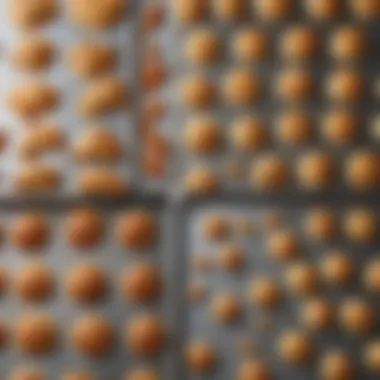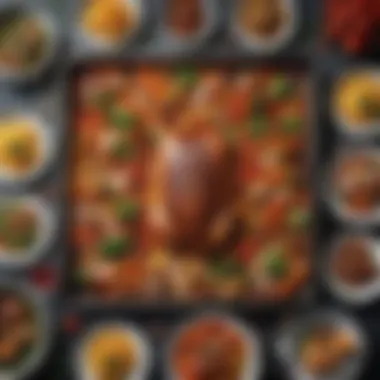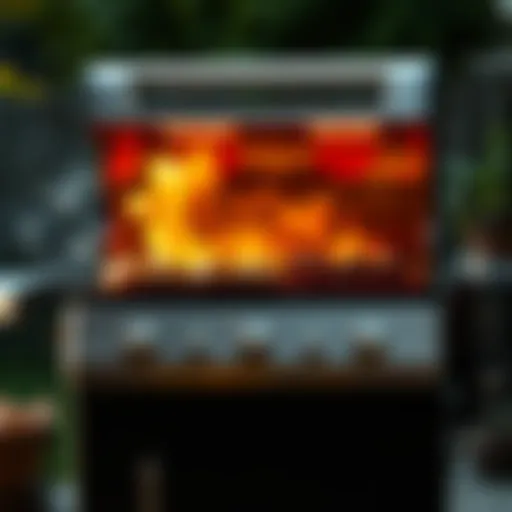The Versatility and Dimensions of Full Sheet Pans


Intro
When it comes to culinary tools, the full sheet pan is one that stands tall, both literally and figuratively, amongst its peers. Its dimensions typically hover around 18 by 26 inches, making it a giant in the world of baking and cooking. But size isn’t everything; the utility of a full sheet pan in both professional kitchens and home cooking is truly remarkable. Whether you’re roasting vegetables, baking cookies, or prepping ingredients, the advantages of using a full sheet pan are numerous.
What makes this piece of kitchenware exceptionally valuable is not just its generous space but its versatility. It can transform the way one approaches meal prep and presentation. As we peel back the layers of this unassuming yet powerful tool, we'll dive into its measurements, material types, and scrupulous uses that can elevate your culinary game, no matter the age or expertise of the cook in your household.
A full sheet pan is more than just a flat surface; it’s a canvas for culinary creativity. We’ll explore its physical properties, why it warrants a place in your kitchen arsenal, and how the right techniques can enhance your cooking efficiency. This journey isn’t merely about how large a full sheet pan is, but rather how it serves up artfully created meals with ease and elegance.
Let’s embark on this exploration of size and utility—where precision and practicality meet the art of cooking.
Understanding the Dimensions of a Full Sheet Pan
Understanding the dimensions of a full sheet pan is key for anyone aiming to master their culinary skills. Whether you're a hobbyist or a seasoned chef, knowing the size and specifications of your cooking tools can significantly enhance your efficiency in the kitchen. A full sheet pan, typically measuring 18 by 26 inches, becomes a versatile asset in culinary practices. It facilitates better organization of ingredients, ensures even cooking, and can even improve presentation of your dishes.
Standard Measurements
When it comes to standard measurements, a full sheet pan stands out in the kitchen for its ample space. With dimensions of 18 inches in width and 26 inches in length, cooks from various backgrounds utilize it for its practical benefits.
- Larger Capacity: It's larger than many other options, like quarter or half sheet pans, allowing you to prepare bigger batches of food, whether you're baking cookies or roasting a medley of vegetables.
- Even Cooking: The size provides plenty of surface area, promoting better airflow and ensure even heating. This helps in achieving desirable textures, especially when baking.
- Compatibility with Ovens: Full sheet pans are designed to fit in standard commercial ovens, which is crucial in professional settings as they increase productivity.
Consider the dimensions not only in terms of size, but also how they relate to your cooking needs. A spacious pan can make a world of difference when preparing family dinners or hosting parties.
Variations in Size
While the full sheet pan holds specific standard measurements, variations exist that may be suited to your specific cooking style or available kitchen space. Many bakers and chefs have experimented with these deviations to address their unique culinary requirements.
- Thin vs. Thick Pans: Some pans come in various thicknesses, where thinner options heat up faster, and correspondingly thicker ones can hold heat longer. This can change the end result significantly, affecting browning or crisping of food.
- Edge Height: Full sheet pans can also differ in edge height, with some having a shallow border and others coming with deeper-rimmed edges. The choice here can impact how well liquids and batters are contained, which is crucial for things like sheet cakes or roasting dishes.
- Material Differences: Different materials impact both appearance and function, with aluminum, stainless steel, and non-stick coatings each offering unique benefits based on size and specifications.
Taking time to understand the variations in size amongst full sheet pans can enhance your culinary endeavors. Investing in suitable dimensions and materials allows you to unleash your creativity in the kitchen, ultimately making preparing your favorite meals more enjoyable.
"Choosing the right size and type of pan isn't just about aesthetics; it can change everything about how a dish turns out."
Familiarizing yourself with the diverse range of full sheet pans can prepare you well for nearly any cooking adventure. Knowing your tools equips you to fully explore their utility in various culinary practices.
Material Types of Full Sheet Pans
When it comes to selecting a full sheet pan, the material is not merely a matter of preference. The type of material plays a crucial role in functionality, longevity, and the overall cooking experience. Different materials carry unique characteristics that influence heat conduction, durability, and even ease of cleaning. Understanding these nuances can significantly enhance culinary practices and outcomes, paving the way for cooking excellence in both home and professional kitchens.
Aluminum Sheet Pans
Aluminum sheet pans are the backbone of cooking in many kitchens. They heat up quickly and distribute that heat evenly, which is often a game-changer for baking tasks. If you bake cookies or pastries, you likely appreciate the browning abilities that aluminum offers.
The lightweight nature of aluminum pans makes them easy to handle, a plus when you’re rushing to and fro in the kitchen. Additionally, they’re usually more affordable compared to other materials, solving many budgetary dilemmas in culinary settings. However, keep in mind that they can warp over time if exposed to extreme temperature fluctuations. So, it's wise to set the oven temp with some caution.
- Advantages: Quick heating, even heat distribution, lightweight
- Disadvantages: Prone to warping, reactive with acidic foods
Stainless Steel Options
Stainless steel is a sturdy and reliable alternative for full sheet pans. These pans typically have a heavier feel and can withstand higher oven temperatures without warping. They not only elevate the aesthetic of your kitchen but also offer versatility. You can roast, bake, or even use them for broiling.
One notable feature a stainless steel pan brings is its non-reactive surface. That means you can bake a batch of lemon bars without the concern that the citrus will affect the taste or integrity of your dish. With proper care, these pans can outlast cheaper alternatives, providing excellent value over time.
- Advantages: Durable, non-reactive, resistant to rust and staining
- Disadvantages: Heavier, less heat-conductive than aluminum
Non-Stick Coatings
Non-stick coatings have become a popular choice for many home cooks and bakers. The appeal lies in their ability to make food release easier and cleanup a breeze—who doesn't love that? A full sheet pan with such a coating can significantly improve the experience when preparing sticky items like roasted vegetables drizzled in honey or caramel-laden desserts.
While they offer great convenience, it’s essential to choose non-stick pans wisely. Some lower-quality coatings can wear off with time or wear down due to high-heat cooking. It’s wise to invest in a reputable brand to ensure longevity and safety. Moreover, you should avoid using metal utensils to prevent scratches that could compromise the coating.
- Advantages: Easy food release, easy to clean, less oil needed
- Disadvantages: Can wear out over time, less durable compared to traditional metals


Choosing the right material for a full sheet pan not only affects the cooking process but also influences the quality of the final dish. Consider your cooking style, budget, and the types of food you often prepare to make the best decision.
Common Uses for Full Sheet Pans
Full sheet pans have become a kitchen staple, not merely due to their size, but also their versatility. Recognizing how and why these pans are employed in a culinary setting can enhance both home cooking and professional practices. The expansive surface area of a full sheet pan allows for numerous functionalities, making them ideal for various cooking methods—from baking to meal prep. Emphasizing the utility of these pans can help improve efficiency in the kitchen, ultimately leading to tastier and aesthetically pleasing dishes.
Baking Applications
When it comes to baking, full sheet pans really shine. Whether you’re whipping up a batch of cookies or tackling a large cake, the room they provide is crucial. It’s not uncommon for home bakers to find themselves wrestling with multiple smaller pans; the full sheet pan eradicates this trial and error.
The advantages are manifold:
- Consistent heat distribution: A larger surface area ensures that your baked goods receive even heat, reducing any chances of burnt edges.
- Batch baking: You can bake multiple trays at once, making it exceptionally convenient for bakeries or during holiday seasons.
- Creative baking: Go ahead and experiment! Cookie bars or sheet cakes can be fun alternatives to traditional cakes.
Remember, the choice of material can affect the outcome, so opt for the right type of pan. For example, aluminum sheet pans are often recommended for baking due to their excellent heat conductivity.
Roasting Vegetables
Nothing beats the flavor of well-roasted vegetables. Full sheet pans are perfect for this task, providing enough space to toss and spread out vegetables. A crowded pan usually leads to steaming rather than roasting, which results in a different texture and flavor profile.
Here’s how to ensure your vegetable roasting game is top-notch:
- Aim for uniformity: Cut your vegetables to similar sizes. This allows for even cooking, ensuring that nothing is undercooked.
- Use high temperatures: Most roasting recipes call for heat settings around 425°F for a reason—this helps caramelize the sugar in the vegetables, enhancing the flavors.
- Add a bit of oil and seasoning: Tossing your veggies lightly with olive oil and salt before roasting can make a world of difference in taste.
The full sheet pan also allows for a variety of vegetables to be roasted together, adding different textures and flavors to your meal.
Meal Preparation Strategies
In the fast-paced world we live in, efficiency is essential, and full sheet pans can be the backbone of meal prep strategies. From organizing components of a meal to cooking entire dinners, these pans truly expand possibilities.
To utilize a full sheet pan effectively in meal prep, consider the following:
- Batch cooking: Use the pan to roast proteins and veggies simultaneously at the start of the week. It keeps your weeknight dinners simple and nutritious.
- Portion control: Preparing meals for the week can also be a breeze. Use sectioned containers to separate portions after cooking directly from the sheet pan.
- Diversity in flavor: By prepping a variety of ingredients, you’re better set for mixing and matching components each day, securing interesting meals throughout the week.
"Meal preparation using full sheet pans not only saves time but also allows you to explore culinary creativity."
Ultimately, embracing the uses of full sheet pans can redefine how you approach your cooking endeavors. They are more than just a kitchen tool; they embody a philosophy of efficiency and creativity in culinary practice.
Benefits of Using Full Sheet Pans
When diving into the world of culinary arts, one quickly realizes that the tools used can make or break the dish. Full sheet pans are paramount in various cooking methods and hold several advantages, especially in a busy kitchen environment. This section will reveal why they are indispensable for both professionals and avid home cooks alike.
Efficiency in Cooking
The first point to consider is how full sheet pans speed up the cooking process. Imagine having a busy day where you need to prepare a family meal while managing other chores. With a full sheet pan, you can cook multiple items simultaneously. For instance, roast potatoes, carrots, and chicken all on the same pan—everything made to perfection while sharing oven space. This multitasking ability saves time and energy, making it a real asset in the kitchen. Each ingredient can receive the right heat, allowing them to roast evenly and meld flavors beautifully.
"A well-used sheet pan is like a trusted friend; it never lets you down in a pinch!"
Maximizing Oven Space
Next up is the space-saving aspect of full sheet pans. These pans, typically measuring 18 by 26 inches, allow a cook to utilize the entire rack in an oven efficiently. Instead of juggling multiple smaller pans that may leave gaps, full sheet pans fit snugly side by side, ensuring every inch of the oven gets utilized. This is particularly beneficial when preparing for gatherings or meal prepping for the week. When the oven is full, the heat distribution remains even, leading to consistent cooking results.
Furthermore, not only can the full sheet pan be used in ovens, but they are also compatible with commercial baking and even some grills, adding flexibility based on how you choose to cook. This adaptability means if you're short on time, you can roast, bake, or even reheat a much larger quantity without needing extra pans cluttering the kitchen.
Versatility Across Recipes
Full sheet pans are like blank canvases. Their versatility is astounding; they can be the base for a variety of dishes ranging from savory to sweet. Use them for meal assembly such as sheet pan fajitas— layer bell peppers, onions, marinated chicken strips, and pop it in the oven for a complete meal that requires minimal cleanup. Alternatively, pour batter for cookies or sheet cakes directly onto the pan for a quick dessert option.
The opportunities for creativity are nearly limitless:
- Savory meals: Roasting veggies, baking fish with herbs, or preparing lasagna.
- Baked goods: Cookies, brownies, or even pizza—all easily rolled out or dropped without the hassle of multiple batches.
Specific Cooking Techniques for Full Sheet Pans


Full sheet pans are not just a kitchen accessory; they are versatile tools that can transform how one cooks. Understanding specific cooking techniques designed for these pans opens up an array of possibilities in meal preparation. Their ample space and even heat distribution offer advantages that are hard to beat in any culinary setting. With this, home cooks and professional chefs alike can create meals that not only taste great but also look appealing on the plate.
Sheet Pan Dinners
The sheet pan dinner is a brilliant concept that has gained considerable traction in recent years. The beauty of these meals lies in their simplicity and the ease of their preparation. One can throw various ingredients onto a full sheet pan—seasoned proteins, vibrant vegetables, and fragrant herbs—and let the oven work its magic. This cooking method stands out for a couple of reasons:
- Flavor Development: When food is cooked together on the same pan, the flavors meld beautifully. As the vegetables soften and the meat cooks, those juices combine, creating a delicious sauce that is ready to serve over the dish. It’s like a mini feast on a single sheet.
- Time-Saving: Who has time to wash up multiple pots and pans? A sheet pan dinner means fewer dishes. After your meal is served, there’s just one pan to clean, making it a perfect solution for busy weeknights—or, let's face it, any night when you’re feeling a bit lazy.
- Customization: Each person can make their own version by mixing and matching ingredients. Whether you’re in the mood for a lemony chicken and asparagus ensemble or something more robust, like a spiced sausage and sweet potato medley, the possibilities are vast.
"A good meal can change your day; a great meal can change your life. The sheet pan dinner is a testament to this idea, proving that simplicity can lead to extraordinary results."
One-Pan Baking Techniques
Baking on a full sheet pan introduces a world of creative opportunities, especially for those who enjoy the art of desserts as much as savory dishes. One-pan baking techniques offer efficiency alongside innovative presentation. Here are a few remarkable aspects worth noting:
- Batch Cooking: Perfect for making large quantities, whether it’s a batch of cookies or brownies. A full sheet pan allows for multiple treats to be baked all at once, ensuring an even texture and consistent doneness. Imagine hosting a gathering – one sheet full of assorted cookies, ready to satisfy various cravings.
- Creative Expanse: The large surface area provides room to experiment. From s'mores bars that seamlessly meld chocolate, marshmallows, and graham crackers all in one pan to shepherd’s pie with crispy edges all round, you can let your imagination run wild.
- Layering Flavors: The depth in flavors achieved through one-pan baking cannot be overstated. For example, consider a fruit cobbler where fruits caramelize beautifully, infusing the dish with a sweet aroma, while the biscuit topping bakes to golden perfection.
Crafting these culinary delights using a full sheet pan is about efficiency, of course, but also about unleashing your inner chef to explore new flavors and techniques. By honing in on these specific cooking techniques, whether it’s for a home-cooked feast or a professional culinary masterpiece, one can truly elevate their culinary game.
Choosing the Right Full Sheet Pan for Your Needs
When it comes to selecting a full sheet pan, understanding one’s specific needs is crucial. The choice impacts not only the cooking process but also the overall success in the kitchen. A mismatched pan can lead to uneven cooking, scorching, or even a downright messy situation. Hence, knowing the essentials before making a choice can save both time and culinary mishaps down the line.
Considerations for Home Cooks
For home cooks, the first factor to ponder is the size and compatibility with the oven. A full sheet pan generally measures about 26 x 18 inches. This size works well in most standard ovens, but before committing, it’s best to measure your oven space. Also, consider the weight of the pan. Heavier pans may be more durable, but they're also trickier to handle, particularly when loaded with food.
Another aspect to consider is the material. Aluminum pans are light and conduct heat well but can warp over time. On the flip side, stainless steel pans are sturdier, but they can take longer to heat. If you're planning to use the pan frequently for roasting or baking, investing in a non-stick option may save you time on cleaning, though it’s essential to choose a high-quality coating to avoid it peeling off.
Finally, assess what you’ll be cooking. If you frequently prepare large batches of roasted veggies, a thick, well-constructed pan is ideal. For projects that involve sticky ingredients, a non-stick surface can be a game changer.
"The right tools can be the difference between a good meal and a great one."
Professional Kitchen Requirements
In professional environments, the stakes are higher, and thus, the criteria for selecting a full sheet pan become even more rigorous. Chefs often look for durability and uniform heating. Commercial kitchens tend to opt for aluminum pans with a heavier gauge. This structural integrity can withstand the wear that comes from daily use.
Moreover, consistency in performance is vital in professional kitchens. Chefs may choose restaurant-grade pans that are specifically designed for high heat applications and can withstand extreme temperature changes when moved from oven to freezer, and back again. These pans often have additional features like reinforced edges that enhance durability.
Here's a quick checklist for professional kitchen criteria:
- Material Quality: Heavier gauge aluminum or high-grade stainless steel.
- Heat Conductivity: Ensures consistent cooking temperatures.
- Maintenance: Easy to clean after multiple uses.
- Stackability: Shouldn't take up too much space in storage.
Storage and Care of Full Sheet Pans
Maintaining the longevity and effectiveness of your full sheet pans goes beyond mere usage; it dives into the importance of proper storage and care practices. When you invest in a full sheet pan, you want it to last as long as possible, right? Well, smart storage and diligent cleaning habits can help with that. Not only do these practices enhance the durability of the pans, but they also ensure that your cooking endeavors remain hassle-free, so you can focus on whipping up those culinary masterpieces.
Cleaning Techniques
Keeping your full sheet pans clean is essential to maintaining their surface and preventing any unwanted flavors from carrying over to your next recipe. Here are some effective cleaning techniques that can make the job less daunting:
- Soak First: For stubborn stains or baked-on residue, soaking the pan in warm, soapy water for a short time can work wonders. After soaking, use a soft sponge or cloth to wipe away the grime without scratching the surface. Non-metal scrubbers are fantastic for this.
- Baking Soda Paste: If you encounter tough spots, creating a paste from baking soda and water can be super efficient. Spread the paste over the problem area and let it sit for a while. Then scrub gently to lift away the stains effortlessly.
- Vinegar Rub: A mix of equal parts vinegar and water can help cut through grease and restore shine. Spray or wipe it on the pan, then rinse off with warm water; it’ll feel brand new.
- Avoid the Dishwasher: Although some pans might claim to be dishwasher-safe, hand washing is generally the best way to prolong the life of sheet pans. Dishwashers can cause scratches and may warp your pans over time.
"A well-cared-for pan is like a trusted friend in the kitchen—reliable and always ready to help you create something great."
Proper Storage Methods
Storing your full sheet pans correctly can prevent warping and damage over time. Here are some key points to consider:
- Vertical Storage: If space allows, standing the pans up vertically can help airflow and reduce the chance of scratches from stacking them. You can create a simple holder or use a designated rack to keep them securely upright.
- Avoid Heavy Items: Stacking heavy pots or pans on top of your full sheet pans is a sure way to create dents or warping. If stacking is unavoidable, place a soft cloth or protective layer between pans to cushion against scratches.
- Cleaning After Use: Ensure your pans are completely dry before storing them. Moisture can lead to rust or unpleasant odors, which can then affect your food.
- Temperature Awareness: Store your pans in a stable environment, away from extreme heat or humidity. These conditions can warp or deteriorate the materials.
These steps, while straightforward, can greatly enhance the lifespan and utility of your full sheet pans. By treating your culinary tools with care, you create a kitchen environment that is not just functional but also inspiring.
Exploring Alternative Culinary Tools


In the realm of cooking, especially within bustling kitchens where creativity meets functionality, full sheet pans often take center stage. However, it’s worthwhile to remember that sometimes the best tool for the job isn’t necessarily a full sheet pan. Exploring alternative culinary tools can broaden your cooking horizons, enhance efficiency, and offer unique flair to your dishes. This section focuses on popular alternatives, their benefits, and considerations for their use.
Half Sheet Pans
Half sheet pans, a lovely cousin to the full sheet version, come in handy for a plethora of culinary tasks. They boast dimensions typically around 13 by 18 inches, making them more manageable in both size and weight. Perfect for home cooks or during those times when oven space is at a premium, half sheet pans offer versatility without sacrificing quality.
- Baking Smaller Batches: If you’re testing out a new cookie recipe, for instance, a half sheet pan allows for smaller batch sizes without committing an entire full sheet. Less waste and easier storage!
- Ideal for Snacks: Those mid-afternoon munchies? Roast some chickpeas or toss your favorite nuts on a half sheet pan and let them crisp in the oven.
- Lively Color: Their size can bring a splash of color to your meals. Use them to roast vibrant vegetables in varied arrangements, keeping meals both visually appealing and flavorful.
Using half sheet pans also means easier cleanup. When meals are prepared in smaller portions, less food is stuck, leading to quicker and less labor-intensive washing. If you're curious about half sheet pans, you could explore discussions on reddit.com for users’ experiences and recommendations.
Other Baking Accessories
Beyond half sheet pans, a myriad of other baking accessories can complement your culinary efforts. Each has its own charm and specialty that can enhance your engagements in the kitchen:
- Silicone Baking Mats: These are a favorite among many in the baking community. Their non-stick surface ensures that your cookies slide off with ease and they can be reused countless times. Plus, they make for easy cleaning afterwards!
- Individual Ramekins: For those who enjoy a little flair in presentation, ramekins are perfect for single servings of molten lava cakes or crème brûlée. They elevate the dining experience to a new level.
- Baking Stones: Crafting pizza or artisan bread? A baking stone can replicate that wonderful brick oven experience. It holds heat exceptionally, giving your dough the perfect crust that’s to die for.
- Cooling Racks: After those delightful treats come out of the oven, a cooling rack is essential. It prevents them from getting soggy and ensures they set perfectly.
Remember that each tool offers its own unique set of strengths. As a culinary enthusiast, don’t shy away from mixing up tools and experimenting. Tapping into the potential of half sheet pans alongside these other accessories can truly transform how you approach cooking.
In summary, while full sheet pans undeniably hold a particular status in the kitchen, alternative tools like half sheet pans and other baking accessories can enrich and diversify your cooking experience. With these alternatives in hand, your culinary creations can reach new heights.
Innovative Recipes Utilizing Full Sheet Pans
The use of full sheet pans in the kitchen extends beyond the basic techniques of baking or roasting. These versatile tools can serve as the foundation for innovative culinary creations, offering ample space to explore flavors and presentations. Wit h their large surface area, full sheet pans allow for the preparation of an array of recipes that cater to various tastes and occasions. Exploring the creative potential of these pans is pivotal in elevating both everyday meals and special culinary endeavors.
Savory Dishes
Savory dishes are where full sheet pans truly shine. The size allows for even cooking and browning, turning ordinary ingredients into something special. One standout recipe is the sheet pan fajitas. By cutting bell peppers, onions, and marinated chicken breast into strips and spreading them across the pan, home cooks can achieve a beautifully caramelized dish that boasts both flavor and texture. This method ensures that every piece receives equal heat, creating a well-rounded dish with minimal effort.
Another compelling example is the classic roasted ratatouille. Using a full sheet pan for this dish allows you to showcase seasonal vegetables like zucchini, eggplant, and tomatoes. Layering these ingredients with olive oil and herbs creates a dish that not only satisfies the palate but also fills the kitchen with an inviting aroma. Roasting on a larger surface means vegetables have the space to caramelize properly, enhancing their natural sweetness.
- Benefits of Sheet Pan Savory Dishes:
- Reduced Cleanup: Fewer pans mean less scrubbing!
- Creative Combinations: Mix various ingredients for a diverse meal.
- Versatility: Easily adaptable to different diets—meatless options abound.
Dessert Options
Desserts crafted on a full sheet pan offer an exciting and unique approach to sweet treats. One popular option is sheet pan cookies. Instead of the traditional method of forming and baking individual cookies, spreading the dough across a full sheet pan allows for thick, chewy cookies with incredible texture. After baking, simply cut them into squares for a no-fuss sweet indulgence.
Another delightful dessert is the sheet pan brownie. Known for their fudgy texture, these brownies benefit from the uniform temperature that a full sheet pan provides. Topped with nuts, chocolate chips, or even a layer of ganache, they can be dressed up for parties or enjoyed simply at home.
"Creativity knows no bounds when utilizing full sheet pans; from savory meals to decadent desserts, these pans elevate any culinary experience."
The beauty of these desserts lies not just in the taste but also in their aesthetic appeal. Layered cakes or custards can be made and presented straight from the pan, combining beauty with practicality.
- Why Choose Sheet Pan Desserts:
- Efficiency: Bake large batches for gatherings without hassle.
- Consistency: Achieve even baking across all your goodies.
- Presentation: Serve directly from the pan for simple yet striking displays.
By utilizing full sheet pans in both savory and dessert recipes, cooks can streamline their cooking processes while offering creative and delicious meals. With the right combination of ingredients and a pinch of imagination, the possibilities are truly endless.
Final Thoughts on the Importance of Full Sheet Pans
Full sheet pans are far from just mundane kitchen tools; they are integral to both the home and professional culinary environments. Their versatility spans the spectrum of culinary tasks, making them valuable for roasting, baking, and meal prep. When talking about utility in the kitchen, full sheet pans emerge as unsung heroes. They not only help in achieving symmetry in cooking but also enable efficient use of oven space, which is crucial, especially in bustling kitchens.
Summary of Key Points
In wrapping up our exploration of full sheet pans, here are some key points to take away:
- Versatility: Full sheet pans can accommodate a variety of dishes, from sheet pan meals to baked goods, allowing for an all-in-one cooking approach.
- Space Efficiency: Their large surface area maximizes the oven's capacity, enabling simultaneous cooking of multiple items.
- Material Options: Different materials bring unique benefits; for example, aluminum offers quick heat conduction, while non-stick coatings enhance ease of cleaning.
- Practicality in Preparation: For meal prep enthusiasts, full sheet pans streamline the process, especially when preparing larger quantities.
With these advantages, it's clear why many chefs, both seasoned and amateur, find solace in using full sheet pans. They facilitate a well-organized cooking experience without cluttering the countertop.
Encouragement to Experiment
For those who might be hesitant to fully embrace their sheet pans, let this be your call to action: don't just stick to recipe books or traditions. Get adventurous! A full sheet pan invites innovation. Try combining flavors that may not typically be paired together; for instance, roasting citrus fruits alongside root vegetables could yield surprising results.
Additionally, consider the visual aspect of your creations. Layering ingredients in distinct sections on the pan can create an appealing presentation right before serving.
As you explore these culinary opportunities, remember that mistakes are part of the learning process. Every dish, whether a success or a flop, adds to your mastery. So roll up your sleeves, preheat that oven, and experiment boldly with your full sheet pan. The kitchen is your canvas; let your creativity shine!















